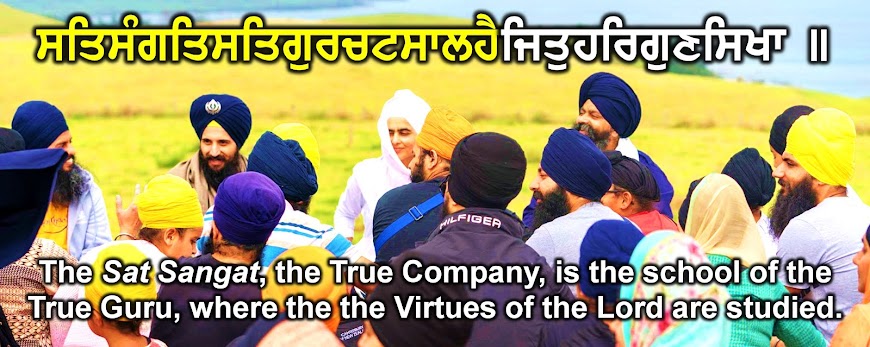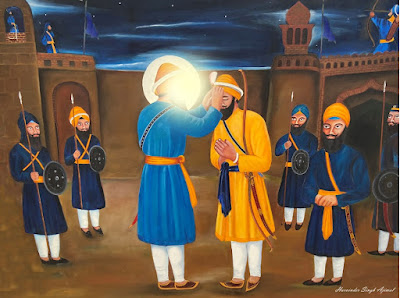This month is very special in Sikh history. It marks the martyrdoms of the four Sahibzaade (princes) of Guru Gobind Singh jee, Mata Gujar Kaur jee (Guru jee's mother) and countless other beloved Gursikhs who died sacrificing themselves for the Sikh nation. As a small tribute to the Sahibzaade and all the great Shaheeds, with Guru's kirpaa Daas has attempted to write up a brief summary of the historical events leading up to Saka Chamkaur Sahib and Saka Sirhind based on lectures of Dr. Sukhpreet Singh Udhoke and Giani Pinderpal Singh.
PART 1: THE STORY OF
LEAVING ANANDPUR SAHIB
Siege of Anandpur Sahib
Anandpur Sahib is in a valley in North-East Panjab. The hills that surround Anandpur Sahib had small kingdoms of 22 Hindu kings. The Hindu kings had a growing enmity with Guru Gobind Singh jee as Guru Gobind Singh jee was against idolatry and the caste system. One of the Hindu hill kings called Ajmer Chand of Kahlir and his father Bheem Chand personally went to the Emperor Aurangzeb and stirred up the Emperor to attack and finish Guru Gobind Singh jee who was said to be a threat to not only the Hindu religion but also the Islamic rule of India. Armies were sent from across Northern India to surround Anandpur Sahib. The army was so big that if each soldier picked up a handful of soil and threw it at Anandpur Sahib, the city would get buried in soil. The siege lasted from about May to December. The food ran out and the Sikhs struggled for even water. Just to get water, a small band of Sikhs would leave the fort and most of them would die fighting in the process. Despite the lack of food, water and the growing cold and wet weather, the Sikhs kept in good spirits.
ਜੇ ਸੁਖੁ ਦੇਹਿ ਤ ਤੁਝਹਿ ਅਰਾਧੀ ਦੁਖਿ ਭੀ ਤੁਝੈ ਧਿਆਈ||੨||
ਜੇ ਭੁਖ ਦੇਹਿ ਤ ਇਤ ਹੀ ਰਾਜਾ ਦੁਖ ਵਿਚਿ ਸੂਖ ਮਨਾਈ||੩||
"If You will bless me with happiness, then I will worship and adore You. Even in pain, I will meditate on You. ||2|| Even if You give me hunger, I will still feel satisfied; I am joyful, even in the midst of sorrow. ||3||"
(Ang 757)
Attempt to attack the Fort of Anandpur Sahib
Guru Gobind Singh jee had his own Intelligence wing that gathered information from different sources. The Head of Intelligence for the Sikhs was called Bhai Chatur Singh Brar. Bhai Sahib informed Guru Sahib three days before that the Mughals planned to send a drunk elephant equipped with lethal armour to break the gate of the Lohgarh Fort. Guru Sahib chose a 4ft tall Singh that was slim build, called Bhai Bachitar Singh jee, to go and fight with the lethal drunk elephant. As the lethal drunk elephant approached the gate, Bhai Bachittar Singh who was on horseback, made a powerful thrust with his spear piercing the elephant's armour plate and injuring the animal in the forehead. The wounded elephant ran back creating havoc and great damage in the enemy's ranks. Bhai Sahib showed that it is not necessarily physical build and strength that is needed for victory but spiritual strength, fearlessness and courage that is gained from Rehit, Gurbani and Simran.
The Oath of the Hindu Hill Kings
The 22 Hindu hill kings sent a Hindu priest called Pandit Parmanand to see Guru Gobind Singh jee. Pandit Parmanand came holding a cow statue made out of flour and told Guru jee, "The Hindu hill kings have sent me on their behalf. They take an oath on the holy cow that if you leave Anandpur Sahib and head for Deena Kangar, they will not attack you and allow you to leave with dignity and respect." Mata Gujar Kaur jee afterwards tells Guru jee, "They are taking an oath on their holy cow. We should perhaps accept this." Guru jee replied, "Mata jee, they are taking an oath on an animal, not even a human being. I will show you how much their oath means to them." Guru jee got some bullock driven carts to be filled with rubbish and then covered with expensive material. Guru jee then asked the Sikhs to send these carts outside of the city gates so that it looked like the Sikhs were leaving. When this happened, straight away the Hindu hill kings got their armies and attacked. Guru jee proved how much integrity these kings really had.

The Oath of Aurangzeb
Aurangzeb then sent a Muslim priest, Qazi Syyed Wali Hassan, to see Guru jee at Anandpur Sahib. The Qazi supposedly belonged to the blood line of Prophet Muhammad. He lived in the city of Samana, which is the same place where the executioners of Guru Teg Bahadur jee and the Chhote Sahibzaade lived. Wali Hassan brought a Quran with him that was handwritten by Emperor Aurangzeb. On the first empty page of the Quran, Aurangzeb had written that he swears on the Quran that if the Guru leaves Anandpur Sahib he will not attack him and let him go peacefully. Guru jee knew everything. Guru jee became a mirror in which the Mughals could see themselves and expose the ugly truth of how treacherous they really were.
Leaving Anandpur Sahib
On the night of 20th December (Panjabi month of 6 Poh), Guru Gobind Singh jee, his family, and all the Sikhs left Anandpur Sahib. As it was night time the Mughals did not realise that Sikhs had left. Imagine if someone asked us to leave our home over night and never to see it again. We would remember the room that we decorated with our own hands, the kitchen that our father made and the garden that our mother looked after. We would be pained to leave it, even if it was a small house. Yet, Guru jee left behind a whole city founded by his father, Guru Teg Bahadur jee, and built up over time by his own hands and the hands of his beloved Gursikhs. Eventually the Mughals got news of Guru jee and the Sikhs leaving Anandpur Sahib. During the night 20th December leading up the morning of 21st December, Guru jee and his Sikhs were attacked by the Mughal army at the river Sarsa, at a distance of about 25 kilometres from Anandpur Sahib. The Mughals broke their oath on Allah and the Quran that they would not attack.
Guru jee and the Sikhs arrived at Kiratpur Sahib and paid their respects there. Guru Gobind Singh jee had his eldest son, along with Bhai Udde Singh jee, Bhai Jeevan Singh jee, and Bhai Bachitar Singh jee, at the back of the caravan of Sikhs to keep back the attacking Mughal army. Guru jee kept his own son at the back to fight so that no one would have any doubt that Guru jee made any distinction between his own sons and the Sikhs. Bhai Udde Singh jee along with 50 Sikhs under his command become Shaheed at Shahi Tibba. Bhai Jeevan Singh along with 100 Sikhs under his command become Shaheed fighting in another direction. Bhai Bachitar Singh who was also commanding a group of Sikhs ahead of Guru jee and the rest of the Sikhs in the direction of Ropar was wounded and eventually becomes Shaheed. The accompanying group of Sikhs with Bhai Bachitar Singh all became Shaheed. Guru Gobind Singh jee asked the Sikhs to stop and sit down at the river bank of River Sarsa for Amritvela Nitnem (morning prayers). Bhai Dya Singh jee, said, "But Guru jee, the enemy is coming..." Guru jee replied, "A Sikh's wealth is Amritvela and Bani. Without it, the enemy can finish you anywhere and you will not get to God." That Amrit-vela, Guru jee himself recited Nitnem and then led the Keertan of Aasa Ki Vaar. Guru jee proved to Sikhs the importance of Amrit-vela and Nitnem (daily prayers).

Separation of the Family
After Aasa Ki Vaar keertan, Guru jee and the Sikhs moved towards the River Sarsa to cross it. It was the early morning of 21st December. The sun had not yet risen and it was dark with stormy weather. Guru jee's family members and the Sikhs were on horses. The river was cold and the water was flowing very fast. Many Sikhs perished in crossing the
cold river and got swept away by the current of the river. During the
confusion in crossing the River Sarsa, Guru jee's family was divided into three directions. In one direction were Guru jee's wives and Bhai Mani Singh jee, the second direction was Guru jee, his two eldest sons and 40 Sikhs, and in third direction was Mata Gujar Kaur jee and the two younger sons of Guru jee, accompanied by Bhai Duna Singh 'Hindoria' and his wife* (*based on Katha Gur Sutan Kee Granth, a historical manuscript written by Bhai Duna Singh but was burnt along with other precious religious literature in 1984 during the Indian army attack on Sri Harmandir Sahib. A copy of this historical manuscript was made by Prof. Piara Singh Padam before it was destroyed in the attack). Gurdwara Parivaar Vichhora
Sahib is built on the spot where the battle occurred and the Gurus
family were separated.
To be continued...


















































